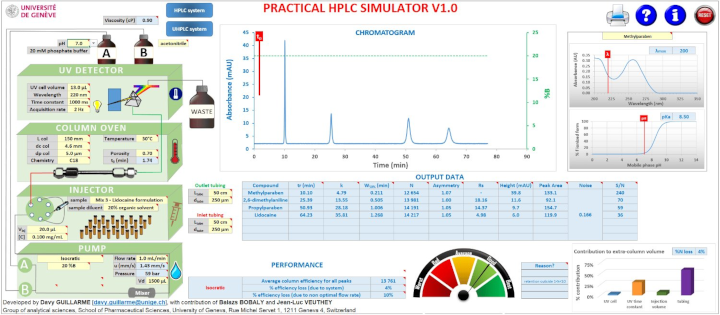Practical HPLC simulator
Practical HPLC simulator : Software for simulation in liquid chromatography

In order to avoid calculation errors, it is important to use the point instead of the comma as the decimal symbol in the regional options of Windows
The macro version allows you to reset the calculator values to the default values with the click of a button. The default values are displayed for the version without macro.
"Practical HPLC calculator" is a tool developed within the pharmaceutical analysis group at the University of Geneva. The main purpose of this calculator is to teach liquid chromatography (RPLC mode) to people with a level comprised between beginner and intermediate. As an example, this software can be the basis of practical work sessions at the university without the need for expensive instruments. It can also be used by professional trainers to illustrate some concepts, using simulated chromatograms.
This software allows a better understanding of the impact of all parameters on chromatographic separation. For this, the user has the choice between 7 different mixtures of compounds containing between 4 and 7 molecules, and can simulate the chromatogram corresponding to any condition, without any real limit.
The user will be able to vary the following parameters: mobile phase (pH and type of organic modifier), pump (elution mode, composition, flow rate, dwell volume), injector (volume injected, concentration, sample type, sample diluent), column (length, diameter, particle size, chemistry, porosity), oven (temperature), UV detector (UV cell volume, wavelength, time constant, data acquisition rate), tubing used in the system (length and diameter).
Thanks to the software, the user will have access to the retention times, retention factors (k'), peak widths at half height, efficiencies (N), peak capacities, asymmetries, resolutions, peak heights, peak areas, and background noise for all compounds under the simulated conditions. The software will also evaluate the efficiency loss due to the instrument (extra-column effects) and will provide the UV spectrum and ionization profile of the analyzed compounds.
It is important to mention that more than 3500 practical experiments were necessary (i.e. 37 molecules, 4 columns, 2 organic modifiers, 4 mobile phase pH, 2 mobile phase temperatures, 2 gradient times), in order to mimic as close as possible to reality the chromatographic behavior of all the compounds that can be analyzed with this software, and the retention models (log kw and S) were also calculated.
For an example of a practical experiment using this software, click here